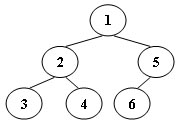03-树3 Tree Traversals Again (25 分)
An inorder binary tree traversal can be implemented in a non-recursive way with a stack. For example, suppose that when a 6-node binary tree (with the keys numbered from 1 to 6) is traversed, the stack operations are: push(1); push(2); push(3); pop(); pop(); push(4); pop(); pop(); push(5); push(6); pop(); pop(). Then a unique binary tree (shown in Figure 1) can be generated from this sequence of operations. Your task is to give the postorder traversal sequence of this tree.

Figure 1
Input Specification:
Each input file contains one test case. For each case, the first line contains a positive integer N (≤) which is the total number of nodes in a tree (and hence the nodes are numbered from 1 to N). Then 2 lines follow, each describes a stack operation in the format: "Push X" where X is the index of the node being pushed onto the stack; or "Pop" meaning to pop one node from the stack.
Output Specification:
For each test case, print the postorder traversal sequence of the corresponding tree in one line. A solution is guaranteed to exist. All the numbers must be separated by exactly one space, and there must be no extra space at the end of the line.
Sample Input:
6
Push 1
Push 2
Push 3
Pop
Pop
Push 4
Pop
Pop
Push 5
Push 6
Pop
Pop
Sample Output:
3 4 2 6 5 1#include<cstdio> #include<cstring> #include<stack> using namespace std; const int maxn = 50; struct Node { int data; Node *lchild, *rchild; }; int in[maxn] = {0}, pre[maxn] = {0}; int num = 0; Node* createTree(int preL, int preR, int inL, int inR); void postOrder(Node *root,int n); int main() { int n; scanf("%d",&n); int x; int preIndex = 0, inIndex = 0; char str[5]; stack<int> s; for (int i = 0; i < 2*n; i++) { getchar(); scanf("%s",str); if ( 0 == strcmp(str,"Push")) { scanf("%d",&x); s.push(x); pre[preIndex++] = x; } else { x = s.top(); s.pop(); in[inIndex++] = x; } } Node *root = createTree(0,n-1,0,n-1); postOrder(root,n); return 0; } Node* createTree(int preL, int preR, int inL, int inR) { if (preL > preR) { return NULL; } Node *root = new Node; root->data = pre[preL]; int k; for (k = inL; k <= inR; k++) { if (in[k] == pre[preL]) { break; } } int numLeft = k - inL; root->lchild = createTree(preL+1, preL+numLeft, inL, k-1); root->rchild = createTree(preL+numLeft+1, preR, k+1, inR); return root; } void postOrder(Node *root,int n) { if (root == NULL) { return; } postOrder(root->lchild,n); postOrder(root->rchild,n); printf("%d",root->data); num++; if (num < n) { printf(" "); } }






【推荐】国内首个AI IDE,深度理解中文开发场景,立即下载体验Trae
【推荐】编程新体验,更懂你的AI,立即体验豆包MarsCode编程助手
【推荐】抖音旗下AI助手豆包,你的智能百科全书,全免费不限次数
【推荐】轻量又高性能的 SSH 工具 IShell:AI 加持,快人一步
· 基于Microsoft.Extensions.AI核心库实现RAG应用
· Linux系列:如何用heaptrack跟踪.NET程序的非托管内存泄露
· 开发者必知的日志记录最佳实践
· SQL Server 2025 AI相关能力初探
· Linux系列:如何用 C#调用 C方法造成内存泄露
· 震惊!C++程序真的从main开始吗?99%的程序员都答错了
· 别再用vector<bool>了!Google高级工程师:这可能是STL最大的设计失误
· 单元测试从入门到精通
· 【硬核科普】Trae如何「偷看」你的代码?零基础破解AI编程运行原理
· 上周热点回顾(3.3-3.9)